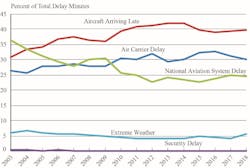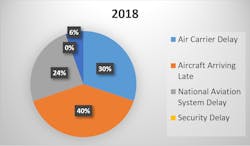Are You Too Busy Playing the ‘Shift Shuffle’ to Turn that Flight Around?
The daily life of airline ground crews can be quite hectic and costly. Getting flights safely out on time is the focus of ground crews. The Federal Aviation Administration (FAA) classifies a flight as late if it misses departure time by 15 minutes. Airlines often struggle to put some padding in to avoid late flights while maximizing aircraft utilization.
We all know overrunning our “scheduled turnaround time” costs money, but how much?
Short delays, on average, cost $74 per block minute for the airline and $49 per hour for passengers. The FAA estimated in 2018 that delays cost $28B, where half of the loss goes to the airlines, and the other half goes to the passengers. If the delay runs over three hours, it gets even more expensive. In the US, the FAA issues fines of $27,500 per passenger if the plane is stuck on the tarmac for more than three hours. US Airlines must pay for passenger lodging costs if the delay or cancellation is their fault, but not if the cause is beyond their control, such as weather. In the European Union, flight delays over three hours, cancelations and denied boarding entitle passengers to between €250 to €600 per passenger.
Is this a big problem? Yes, because 23% of flights arrive late.
Besides acts of God, like weather, and acts of man, like government shutdowns and safety grounded equipment, there are a lot of things that cause delays at airports. Since 2003, the US Bureau of Transportation has been collecting data on air travel delays for airlines serving more than 0.5 percent of the US market. They divide the causes of delay into five categories: Air Carrier, Extreme Weather, National Aviation System, Late-Arriving Aircraft and Security Delays.
But how much do each of these contribute to the problem?
This chart shows it best, by plotting the percent of total delay minutes per cause, and there are some surprising insights.
Your first guess of the costliest problems might have been extreme weather or those darn security lines, but those have the least impact.
In 2018, the breakdown by cause looked like this:
All the other factors cause a late-arriving aircraft. Airlines don’t have control of security, extreme weather or national aviation system delays. As wise men have often said, focus on what you can control. Airlines do control more than 30 percent of the problem, the Air Carrier Delay. Consider that 30 percent of the $28B problem represents an $8.4B opportunity.
What are the leading causes of air carrier delay? Ground crew activities like maintenance, cleaning, baggage handling, fueling, etc. often experience delays. Which brings us back to the ground crew shift shuffle.
The ground crew shuffle is caused by employees being late, calling in sick, poor scheduling, undesirable schedules, etc. At ShiftX, we help you plan to succeed with automated shift and vacation scheduling.
As Benjamin Franklin is credited with saying, “If you fail to plan, you are planning to fail.”
ShiftX, which focuses on the 67 percent of airline staff that works below the wing, helps users create a comprehensive staffing plan and improves shift coverage to get your flights out on time.
ShiftX simplifies ground crew management through automated planning tools for shift scheduling and vacation scheduling. Automated and transparent preferential, delegate and buddy ‘Schedule Bidding’ means employees don’t have to be there to bid on shifts. Administrators can quickly setup, monitor and publish awarded shifts.
Automated and transparent preferential, delegate and buddy ‘Vacation Bidding’ enables employees to get their preferred vacation from anywhere. Admins can easily publish vacation overrides after award.
This preferential bidding system allows ground crew to specify preferences, bid on shifts by priority, transparently see shifts assigned to others, and participate in bids from anywhere. To determine the optimal schedule lines, ShiftX has an open API to integrate with other shift planning tools.
Starting with a great plan eliminates a lot of waste, but things don’t always go as planned. ‘Shift Trading’ allows employees to find replacements for their shifts from their phones. If they can’t trade a shift, they may need to request an absence. ShiftX’s ‘Lost Time Prevention’ system enables self-service absence reporting. The Lost Time Prevention improves attendance and reduces fraud by enforcing and tracking attendance policies. The company’s web-based absence request portal and automated voice response system means users can inform employees of potential policy violations before they happen.
The holes left in schedules after all of this can be challenging to fill. ShiftX provides ‘Open Time Optimization’ to piece together individual shifts into sensible schedule lines that can quickly be bid on by reserve staff. Open Time Optimization reduces the need for individual overtime shifts. ShiftX can ‘Optimize Overtime’ by enforcing the user’s rules and providing an automated overtime request system.
ShiftX is a cloud-first, mobile-friendly, purpose-built extensible scheduling platform customizable for business needs. Find out more about how ShiftX can reduce operation costs, improve employee satisfaction, and land more flights on time at www.shiftx.ai.
Guy Bieber is Product Manager at ShiftX.ai, where better scheduling creates better business. Guy is a senior technologist, entrepreneur and author.




